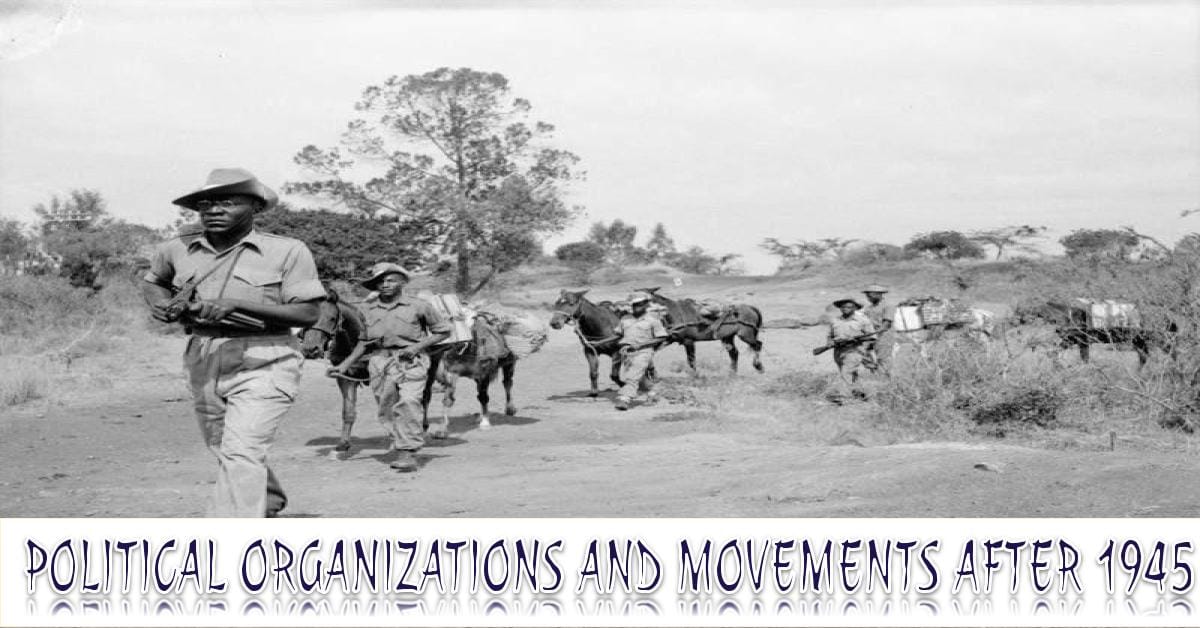📜 Constitutional Changes Leading to Kenyan Independence 🇰🇪
The Journey to African Representation in the Legislative Council (LegCo)
👥 Early African Representation in LegCo
African representation in Kenya’s Legislative Council marked a crucial step toward self-governance and independence.
- ▶️1944: Eliud Mathu, former teacher at Alliance High School, became the first African appointed to the LegCo.
- ▶️1946: KAU’s demands led to the appointment of Benaiah Ohanga as the second African to the LegCo.
- ▶️1948: Representation grew to 4 Africans, compared to 11 Europeans, 5 Asians, and 2 Arabs.
📋 Significant Commission Reports
Various commissions recognized the need for greater African involvement in administration and reduced settler influence.
📘 East African Royal Commission (1955)
- Proposed an end to racial segregation
- Recommended increased African involvement in colonial administration
- Suggested opening Kenya Highlands to all races
📙 Swynnerton Plan (1954)
Proposed consolidation and registration of African land for better land management
📗 Lidbury Commission
Recommended better pay for African workers in the civil service
🔄 The Lyttelton Constitution (1954)
Following the Mau Mau Uprising, the British Secretary for Colonies proposed significant constitutional changes:
- ✅Established a multi-racial Council of Ministers with one African (B.A. Ohanga), two Asians, and three Europeans
- ✅Lifted the ban on African political associations (1955), allowing district-based organizations
- ✅Allowed Africans to participate in the 1957 elections (with qualifications based on income, property, and education)
- ✅Established direct African representation in LegCo
🏛️ African Representatives Elected in 1957
Tom Mboya (Nairobi)
Masinde Muliro (Northern Nyanza)
Oginga Odinga (Central Nyanza)
Lawrence Ogunda (South Nyanza)
Ronald Ngala (Coast)
Daniel Arap Moi (Rift Valley)
James Miumi (Ukambani)
Bernard Mate (Central)
🤝 African Elected Members Organization (AEMO)
The elected African representatives formed AEMO with Oginga Odinga as chairman and Tom Mboya as secretary.
🎯 AEMO’s Key Demands:
- Protested the fewer African positions in LegCo (29 elected vs. 30 nominated members, mostly Europeans)
- Demanded universal suffrage for all Africans aged 21+ regardless of education or income
- Called for voter registration on a common roll
- Demanded an end to the State of Emergency
🦸 AEMO’s Role in the Independence Struggle (up to 1963):
- Formed pressure groups demanding greater political rights for Africans
- Created the core team that pressurized for independence
- Raised African grievances in international forums
- Networked with other African nationalists (e.g., in Ghana and Nigeria)
- Fought for the release of detained nationalists like Jomo Kenyatta
- Formed national political parties (KANU and KADU) that led to independence
- Educated and created awareness among the masses about the nationalist struggle
- Participated in formulating the independence constitution
Kenya’s journey to independence was shaped by these constitutional changes and the determined efforts of African representatives. 🇰🇪
📜 The Lennox-Boyd Constitution & Path to Independence 🇰🇪
Constitutional Developments from 1958 to Full Independence in 1963
📋 The Lennox-Boyd Constitution (1958)
Sir Allan Lennox-Boyd, the new Secretary of State for Colonies, visited Kenya and proposed these constitutional changes:
- ✅Increase of six LegCo seats for Africans, bringing their total representation to 14 seats
- ✅Introduction of special membership in LegCo, with four members from each race elected by other LegCo members
- ✅Increase of African ministers to two
❌ AEMO’s Rejection:
AEMO rejected these proposals, arguing they still favored white monopoly, particularly the special membership system. They also:
- Demanded unconditional release of Jomo Kenyatta
- Boycotted LegCo from 1958-1959 until a new constitutional conference was promised
⚠️ Acts of Betrayal:
Musa Amalemba and Wanyutu Waweru accepted special seat appointments, with Amalemba becoming the second African Minister for Housing in 1958
🔄 Political Developments in 1959
👔 New Kenya Party (NPK)
White moderates led by Michael Blundell (resigned as Minister of Agriculture) advocating multi-racialism, backed by 46 non-African LegCo members
⚪ United Party (UP)
White extremists led by Captain Briggs demanding abolition of LegCo and replacement with regional assemblies to preserve white highlands
🤝 Kenya National Party (KNP)
Formed by moderates Ngala, Moi, Mate, Towett and Nyagah after resigning from AEMO, advocating multi-racialism. Joined by all Arab and Asian members.
✊ Kenya Independent Movement (KIM)
Radicals led by Mboya, Odinga and Gikonyo Kiano with exclusively African membership. Demanded constitutional conference and Kenyatta’s release.
🏛️ First Lancaster House Conference (1960)
Convened by Ian MacLeod, Secretary of State for Colonies, attended by all LegCo members. African team led by Ronald Ngala with Tom Mboya as secretary.
📋 Conference Decisions:
- 12 elective seats in LegCo remained intact
- 33 open seats to be vied for on a common roll
- 20 reserved seats: 10 Europeans, 8 Asians, 2 Arabs
- Council of Ministers altered: 4 Africans, 3 Europeans, 1 Asian
- Authorization of countrywide political parties for Africans (KANU and KADU formed)
👨💼 African Ministers Appointed:
- Ronald Ngala – Minister for Labour, Social Security and Adult Education
- Julius Gikonyo Kiano – Minister for Commerce and Industry
- Musa Amalemba – Minister for Housing, Common Services, Probation and Approved Schools
- James Nzaui Miumi – Minister for Health and Welfare
🤝 New Political Alliances:
- Kalenjin Political Alliance (Taita Towett)
- Coast African Political Union (Ronald Ngala)
- Kenya African People’s Party (Masinde Muliro)
🗳️ 1961 Elections:
KANU won but refused to form government demanding Kenyatta’s release. KADU formed coalition government with Europeans and Asians.
Kenyatta returned on 21st August 1961, with Kariuki Njiiri offering his Murang’a seat to enable Kenyatta to join LegCo.
🕊️ Second Lancaster House Conference (1962)
Called by Secretary for Colonies Reginald Maulding to draft independence constitution acceptable to KADU and KANU, and reconcile differences.
KANU delegation led by Jomo Kenyatta, KADU by Ronald Ngala. KANU conceded many points to enable successful negotiations.
📜 Main Provisions of Independence Constitution:
- Regional/Majimbo government with regional assembly and president for each region
- Bicameral parliament: Senate and House of Representatives
- Prime Minister as Head of Government, Queen as Head of State represented by Governor General
- Multiparty system with majority party forming government
- Bill of Rights protecting individual rights
🗳️ 1963 Elections:
KANU won with 73 seats against KADU’s 31 and APP’s 8. Jomo Kenyatta became first Prime Minister on 1st June 1963.
🎉 Independence Achieved!
On 12th December 1963, Kenya attained full independence.
On 12th December 1964, Kenya became a republic with Kenyatta as executive president.
Kenya’s journey to independence culminated in these historic constitutional developments and the birth of a nation. 🇰🇪

